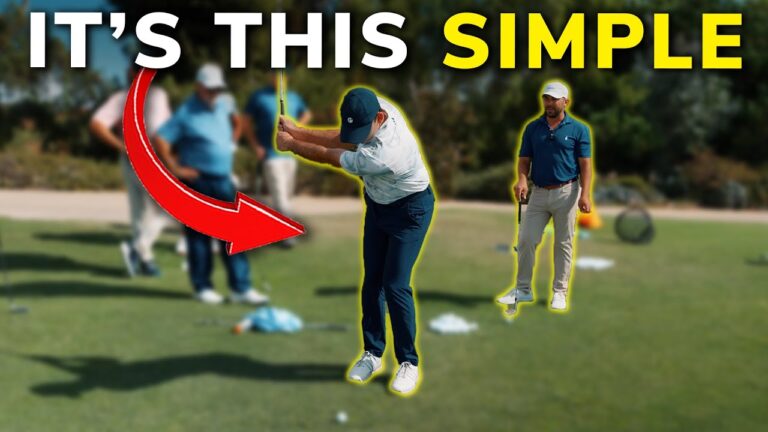
Nail the perfect high soft shot every time with our simplified approach. Learn the secrets to transforming this intimidating move into a trustworthy tool on the green.
Step 1: Ball Position and Why Playing It Forward Matters
Begin with the ball forward in your stance, ideally near your front foot. This position elevates the ball effectively while allowing the open clubface to perform its function. Position the ball near your left heel if you’re right-handed, ensuring the club slides beneath the ball to achieve higher trajectories.
- Position the ball forward for optimal loft.
- Maintain an open clubface to trust the setup.
- Avoid standing back or scooping the ball.
Step 2: Clubface Setup — How Much Open Is Enough
Adjust your clubface to appear open relative to your target. This setup, combined with a proper ball position, allows the club to slide under the ball. Avoid flipping the club at impact; keep your hands steady and synchronize the swing.
- Open the face pre-swing for optimal effectiveness.
- Maintain the face open throughout impact.
- Keep the ball forward to aid in loft.
Step 3: The Swing Sequence — One, Two, and the Delay
For a high soft shot, stay calm and focus on a consistent count of “one, two.” Feel a slight pause at the top of your swing, an integral component of rhythm that facilitates a smooth interaction with the ball.
- Adopt a regular setup with the ball forward and face open.
- Count “one” during your backswing and keep it smooth.
- At the top, delay slightly before continuing “two” on the downswing.
Step 4: Rhythm and Tempo — The True Stopper
The key to stopping power is a moderate and consistent swing speed. Effortlessness in rhythm leads to controlled distances.
- Select swing length as your primary distance control method.
- Consistent rhythm leads to improved distance control.
- Use a counting system for consistent swing pace.
Step 5: Impact Thought — Do Not Add Loft
Refrain from forcing loft by flipping your wrists. Instead, let the open face guide your shot naturally for a gentle landing.
- Focus on the club sliding under the ball.
- Keep hands and body moving together.
- Trust your setup to give the ball height easily.
Step 6: Controlling Distance — The Backstroke, Not the Throttle
Distance management relies on the length of your backswing—longer for more distance and shorter for less, irrespective of swing speed.
- Aim for a target, adjusting backswing length while maintaining tempo.
- Practice backswing lengths to perfect distances.
Step 7: Managing Different Lies — When Spin Helps and When It Does Not
Clean lies offer backspin opportunities, while tougher surfaces require focus on rhythm and the correct setup for success.
- Clean lies may deliver beneficial backspin.
- Poor lies need a focus on rhythm and position.
Step 8: Common Mistakes and How to Fix Them
- Avoid flipping wrists; maintain cohesive movement.
- Prevent rushing by maintaining a steady count.
- Trust setup; an open face is key.
- Use your body for the backswing, not just hands.
Step 9: Practice Progression — How to Build Confidence
Work progressively on all aspects from setup to varied lies, nurturing the feel over the result for consistent improvement.
- Exercise setup and face awareness with small swings.
- Rehearse tempo and pauses without a ball.
- Practice varying your distance through backswing lengths.
- Adjust for different lies to enhance consistency.
Step 10: On-Course Application and Shot Selection
On the course, use practice insights to choose landing zones and manage pressure with a relaxed, rhythmic one-two swing.
- Visualize and land the ball strategically on the green.
- Under pressure, stick to the one-two rhythm.
FAQ
How far forward should I play the ball for a high soft shot?
Position it forward near your front foot to naturally lift the ball without relying on hand movements.
Should I open my stance when I open the clubface?
An open stance might help if it suits your balance and visual alignment, but isn’t necessary if it feels uncomfortable.
Is this shot a power shot?
No, this is a finesse technique leveraging rhythm and precision over power.
How do I avoid chunking when trying to hit this shot?
Prevent chunking with a synchronized one-two rhythm and allowing the club to glide rather than scoop.
How should I practice distance control for different flag locations?
Utilize a consistent count and varied backswing lengths to match target distances effectively.
Focus on these key steps to enhance your high soft shot competency, making it a less intimidating, more reliable part of your golf game.


0 Comments